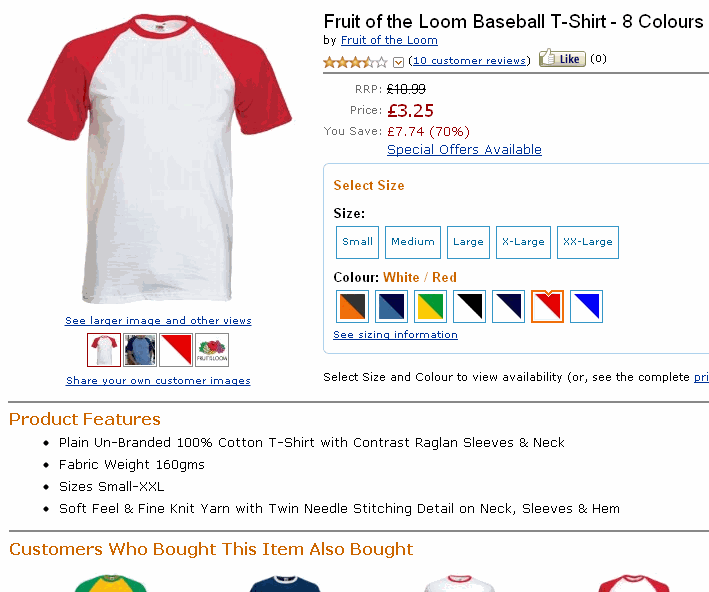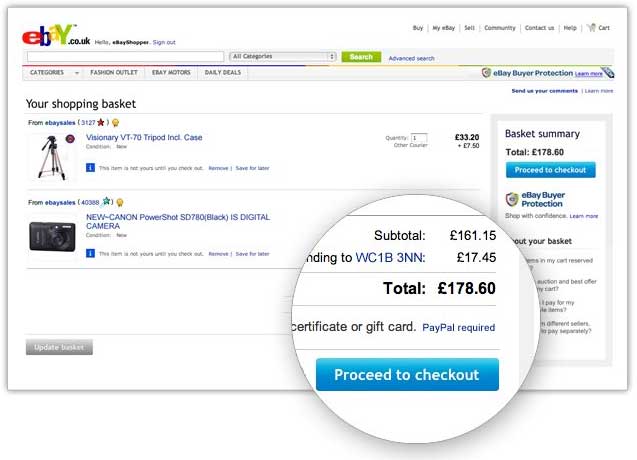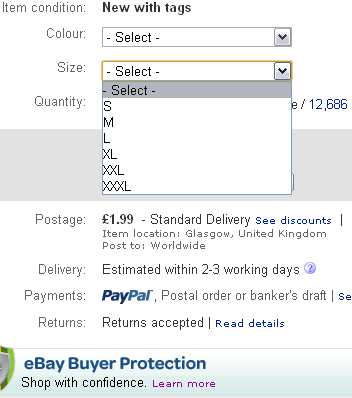Introduction
 This is the first of several articles I have lined up, the best place is to start is in the beginning and with the history of the eSellerPro.
This is the first of several articles I have lined up, the best place is to start is in the beginning and with the history of the eSellerPro.
In the next few minutes I will be sharing the previously untold history of eSellerPro, then in future articles moving into the top three reasons why I believe eSellerPro is better than comparable products such as ChannelAdvisor, then I will be taking a look at other parts of the software from an outsiders perspective and how it can be applied to your business.
Disclaimer
It may seem odd to be starting with a disclaimer, rather than at the end, however I feel it is important that I state, clearly and openly the following facts regarding myself and my interactions with eSellerPro.
1. I am a Former Employee of eSellerPro.
Starting as their third implementer to deploy the software to clients, I very quickly picked up the product from my past experiences as both a seller and managing similar clients previously at MarketWorks. In a relatively short space of time, I was the Implementations team leader and not only training new staff, managing the implementations team.
2. I am an Advocate of eSellerPro
Now this may seem contradictory, however the line is very clear, I left eSellerPro due to personal reasons, one of which was how the company was structured at the time. Since then funding has been sourced and the company has moved from a solely CTO led company, to now a board of directors, with an externally appointed CEO to lead the expanding team.
eSellerPro (as in the product itself) is in my mind, is brilliant. I have to say this as I enjoyed influencing the way it built up over the ~3 years I was part of the team. It was once interestingly described as “a core product with a customisation layer”, although it just so happens that the customisation layer is rather deep and can be quite complicated at times.
I have the upmost respect for team there and have no wishes to upset any carts. I was once amusingly asked if I was a “eSellerPro Pro”, today if asked, I’d reply with no, “Im Pro eSellerPro”. How’s that for a tongue tie?
3. I Use eSellerPro
I now work directly with My1stWish Ltd, they were actually the first business I implemented with eSellerPro. They use eSellerPro as their base software product and it is still used today to demonstrate how the eSellerPro system can be deployed to prospective clients.
4. I’m not a Sales Rep
I am not a sales rep and I am not receiving any commission. If you are seriously considering using eSellerPro and haven’t spoken to them yet, do so and ask for “Miles”.
The Unofficial eSellerPro History
I used to use Marketworks for my own business, after wrapping that up, I ended up working for them in implementations and as their UK support representative. This is how I know where eSellerPro started from and also why. I’ll explain in detail in the next few hundred words or so.
eSellerPro most interestingly started because of the failure of Marketworks.com & ChannelAdvisor to adapt to the UK Market properly. A Software developer was brought in by a customer of MarketWorks (I will now abbreviate to MW) to integrate their MW account and sales orders to Royal Mail, for invoices and large scale despatch. Remember this point, I’ll be referring to it later as I feel there might be a silly mistake about to be made all over again.
The Landscape in 2005-2007
 At the time there were only two real contenders in the ‘Auction Management Software’ arena, MW and Channel Advisor. Yes there were others such as Afterbuy, Spoonfeeder, eBay’s own Selling Manager Pro (SMP) and the likes of Auctiva and similar. They were all pretty basic, it was only CA (ChannelAdvisor, I’m abbreviating that as well) and MW that could offer a eBay selling tool to a degree of complexity and offer (relatively, for their time) semi-decent websites.
At the time there were only two real contenders in the ‘Auction Management Software’ arena, MW and Channel Advisor. Yes there were others such as Afterbuy, Spoonfeeder, eBay’s own Selling Manager Pro (SMP) and the likes of Auctiva and similar. They were all pretty basic, it was only CA (ChannelAdvisor, I’m abbreviating that as well) and MW that could offer a eBay selling tool to a degree of complexity and offer (relatively, for their time) semi-decent websites.
Interestingly, the developer who was brought in by the MW customer, developed another application for processing MW orders into SAGE. This was quite interesting to MW as they saw the chance to secure more customers with this and I believe an agreement was made to deploy this to customers for a set monthly fee (as they did not have this, CA had it via TradeBox). I can only remember two customers who purchased this application, although I am sure there more.
The entry point into ‘Auction management Software’ must have been enough for the developer, Chris Farrelly to realise that this is potentially a market for a similar product to MW, although quite a good product for its time and ChannelAdvisor was in front a little, both were extremely US orientated and there could be the opportunity for a product to rival both, but home grown and UK centric.
A side note here, this that unbeknown to me until quite recently, because of MW and CA’s short sightedness in the UK, led to the development of another software product called 247 TopSeller which had to have been started in a 2-3 month window of that of eSellerPro being first developed.
I left MW a few months after, it was a team of 4/5 that turned into a team of 1, the then “EU Director” Mike Searle’s, after his unprecedented hatred and consistent rants about CA, their questionable and I add wholly unethical practices at the time (they have got better), actually left and joined CA. That marked the beginning of the end and not long after, Marketworks.com was bought by Channel Advisor on the 12th September 2007 for an undisclosed sum (an unconfirmed rumour was it was a “fire sale”).
An Amazing Stint at eSellerPro
I was working for a Diamonds firm in London when I received a call from a chap called Matthew Dean, he knew too much about me (quite flatteringly actually), as he had been trying to track down the right individual to help him expand a company that he had invested in, which was called ‘eSellerPro’ and my name kept appearing.
I met Matthew several times before agreeing to terms, one thing I quite happily boast about seeing the eSellerPro product for the first time, is that I could either see that the product that could solve every issue that I had at Marketworks, both as a user and a supporting party or could, with my guidance, solve them better than anything that had been conceived before. And today it does.
From the day I first met Chris, to the day I left the team, it was one hell of a coding bender and quite a ride. I’ve heard phrases such as ‘working 18 hours so that you do not have to work 8 hours for someone else’, however this was different, Chris’s lust for development was and probably still is unprecedented by anything I have ever seen and will ever see again.
When I first started, eSellerPro did have an employee in the USA called Karen Newton, quite frankly she was not that well supported (probably my fault to be honest, I should have realised) that well and with what was nightmare of a customer, it was no real surprise that we were told that she was no longer working on US clients and they were to be handled by support (there were no true support representatives at the time, the queue was managed by implementers and developers directly).
The Past CEO
I believe it was around May 2009 that a CEO was brought in, a chap called Paul Ayres, it was quite a momentous occasion, as for the first time I personally saw a chance for the business to gain a commercial aspect (as you can imagine, a CTO led company is extremely development focused and could become frustrating after a long enough period of time).
This sadly did not actually last for long and we were told, rather unceremoniously in a meeting that Paul had departed the company. Why things didn’t work out with Paul I’m not 100% sure, maybe it was too early, maybe it was a clash of true interests. I understand that he is now working on a social networking product called ‘MyCube’ and wish him the best for his new venture.
The Investment
In September 2010, several months after I had departed, it was announced that eSellerPro had secured funding by Notion Capitol for £2 million pounds, a new board would be created and a CEO employed. Frankly this was the second best thing to happen to eSellerPro after Chris’s & the teams relentless work on the product.
Now I did not realise how major this sell out was until I looked at the submitted accounts. Business Finance is a personal weakness and I need to nail this for my pending MBA studies, so what better place to start with is companies that I know about first hand.
Before the investment (see here for press release), the share distribution looked something like this:
Pearce – 70
Barker – 50
Milton – 100
Newton – 50
Dean – 70
Terry – 52 (Ordinary B)
From a total of 1052 shares, this left 660.
However on checking the share make up after the sale, they looked quite differently.
Barker – 50
Milton – 0 (these were transfer on 11-06-2010)
Newton – 50
Dean – 70
Terry – 52 (Ordinary B)
Dean – 70
Notion Capital – 420 (Ordinary B)
Ben White – 15 (Ordinary B)
Ian Milbourn – 15 (Ordinary B)
Shares allocated for staff & other parties – 167 (Ordinary C)
From a total of 1052 shares, this leaves just 143.
With the shift in assets appear as quite a drop for Chris, however to have managed to retain a decent chunk of the coupled in with the likelihood of contractual benefits as part of the process; Chris has most likely done very well, especially if you consider the background of Notion Capital in technology based companies.
A side note here is that I personally don’t think Notion Capital really knew what they were buying, it is not a ‘Lemon’ by any means, however I personally do not believe it will be a quick flip that they have enjoyed with previous ventures like Brightpearl.
eSellerPro Lite
Unbeknown to most outside parties, there is a secondary product called ‘eSellePro Lite’, a web based version of eSellerPro developed for RoyalMail. I am not sure on the viability of this option, although in theory, it could be a direct like-for-like rival to CA as it is browser based.
The United States is an obvious place to expand to, I’m aware that an office is being sourced, although a friendly tip here to eSellerPro is to remember the history of eSellerPro and why it started. Making the same mistakes that originally spawned the idea would be a bit silly, especially on their home turf.
Now at the present day, eSellerPro has bulked out quite heavily head-count-wise, there are dedicated support representatives, the development team has literally tripled in size and the same can be said for the implementations team. A board is in place, with Chris, Ben White, Ian Milbourn and the CEO Keith Bird.
The End…
This concludes “The Unofficial History of eSellerPro”. I hope this has given you an insight to eSellerPro that you’d never been told of elsewhere and an understand of where it has come from and possibly where its going too.
If you have any specific questions, feel free to ask them in the comments section at the bottom of this article.
 In case you’ve missed it, eSellerPro are holding their first public customer conference at Lords on the 15th September. The line up includes the usual suspects, eBay, PayPal and lunch. However MoneyBookers, Profulfillment & Priceminister have presentations in the afternoon, which is a first as I’m aware for an event such as this.
In case you’ve missed it, eSellerPro are holding their first public customer conference at Lords on the 15th September. The line up includes the usual suspects, eBay, PayPal and lunch. However MoneyBookers, Profulfillment & Priceminister have presentations in the afternoon, which is a first as I’m aware for an event such as this.

 Website Efficiency
Website Efficiency Just in case you’ve not had an update, the 3rd party checkout system that was employed at Channel Advisor is being removed on the 18th May. You can see the full update and requirements
Just in case you’ve not had an update, the 3rd party checkout system that was employed at Channel Advisor is being removed on the 18th May. You can see the full update and requirements 

 Below I do my best to answer these four underlying questions for you:
Below I do my best to answer these four underlying questions for you: This option is normally chosen by merchants that are on the edge or so rammed up the whole idea of selling on eBay arse, that they get stuck, throw toys around and eventually burn out. Lets hope your competitors either do not twig there is an update at all or select this option.
This option is normally chosen by merchants that are on the edge or so rammed up the whole idea of selling on eBay arse, that they get stuck, throw toys around and eventually burn out. Lets hope your competitors either do not twig there is an update at all or select this option.


 At the time there were only two real contenders in the ‘Auction Management Software’ arena, MW and Channel Advisor. Yes there were others such as Afterbuy, Spoonfeeder, eBay’s own Selling Manager Pro (SMP) and the likes of Auctiva and similar. They were all pretty basic, it was only CA (ChannelAdvisor, I’m abbreviating that as well) and MW that could offer a eBay selling tool to a degree of complexity and offer (relatively, for their time) semi-decent websites.
At the time there were only two real contenders in the ‘Auction Management Software’ arena, MW and Channel Advisor. Yes there were others such as Afterbuy, Spoonfeeder, eBay’s own Selling Manager Pro (SMP) and the likes of Auctiva and similar. They were all pretty basic, it was only CA (ChannelAdvisor, I’m abbreviating that as well) and MW that could offer a eBay selling tool to a degree of complexity and offer (relatively, for their time) semi-decent websites. I’ve been really quiet again on the article front this week again. I’ve not given up, quite the opposite. I’ve been beavering away in the background updating other
I’ve been really quiet again on the article front this week again. I’ve not given up, quite the opposite. I’ve been beavering away in the background updating other  This article is a continuation of a previous article called
This article is a continuation of a previous article called 

